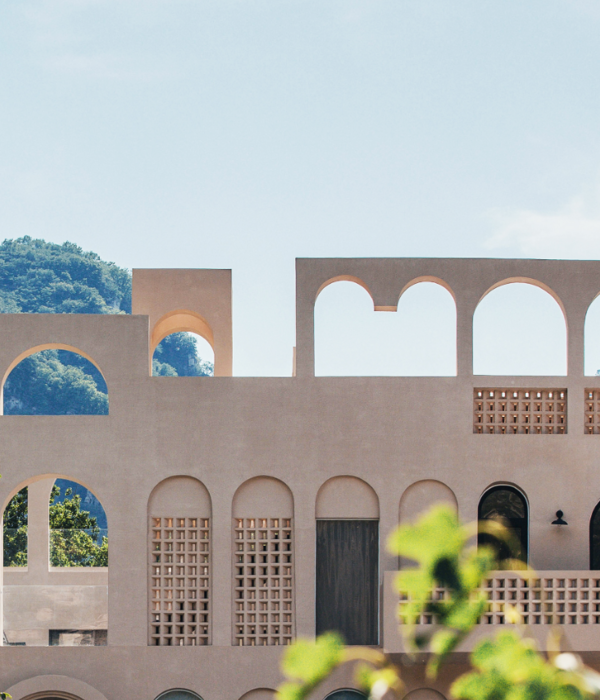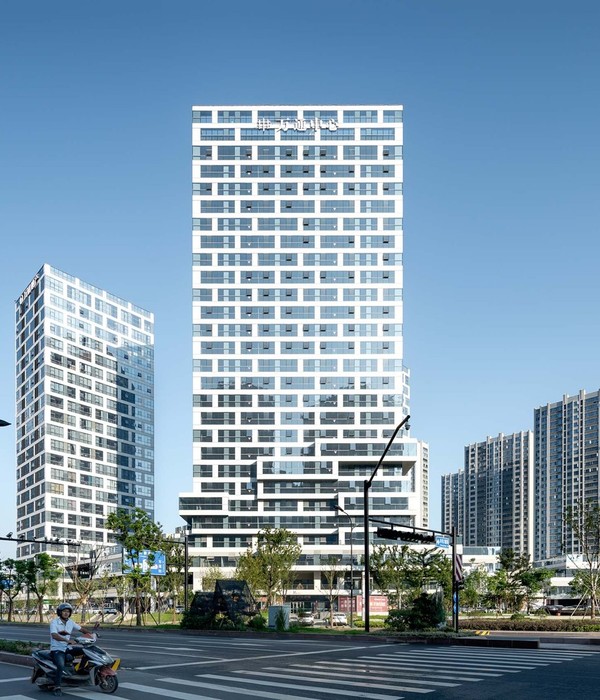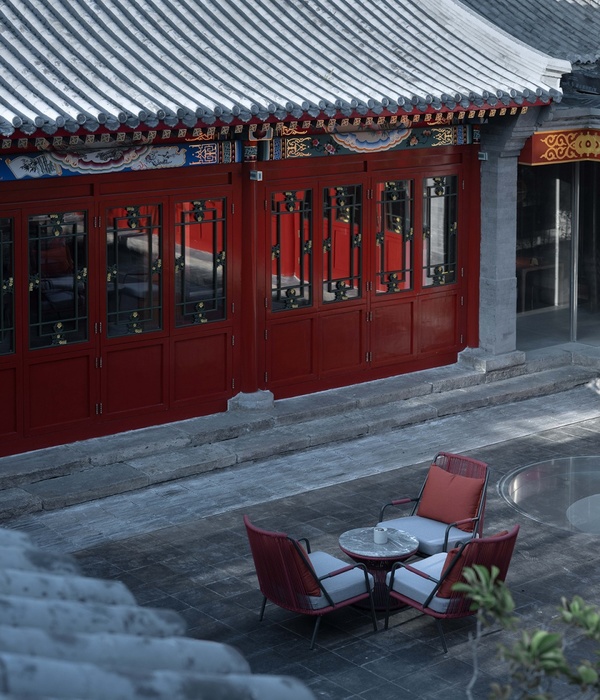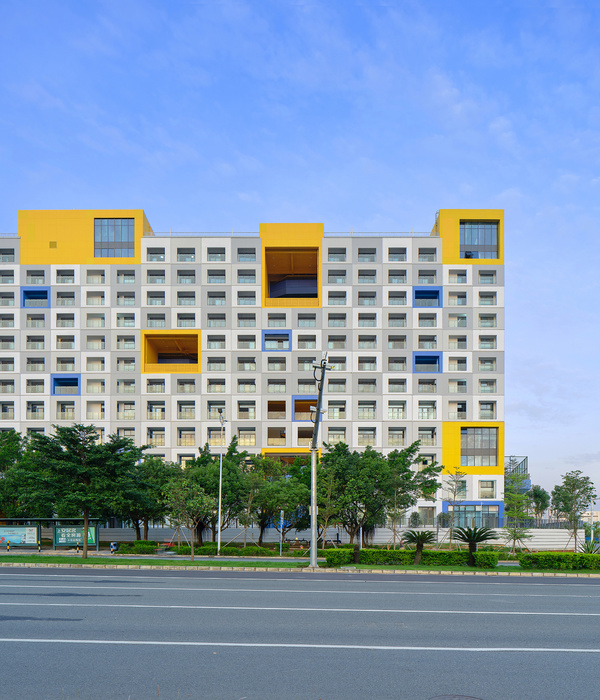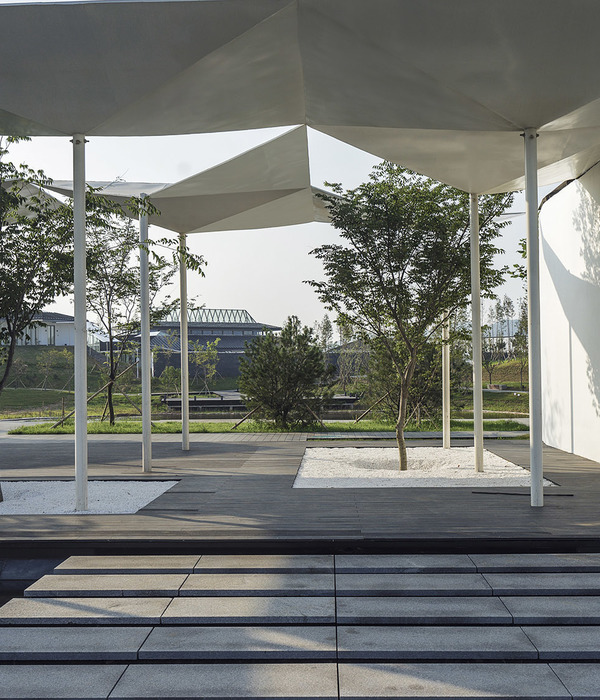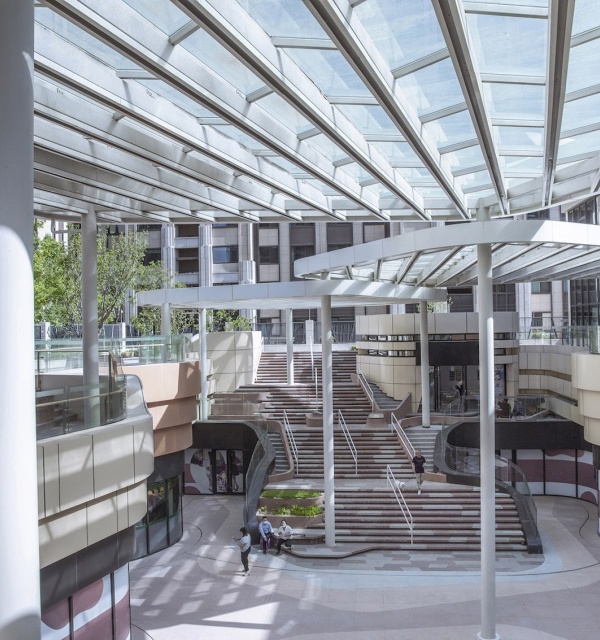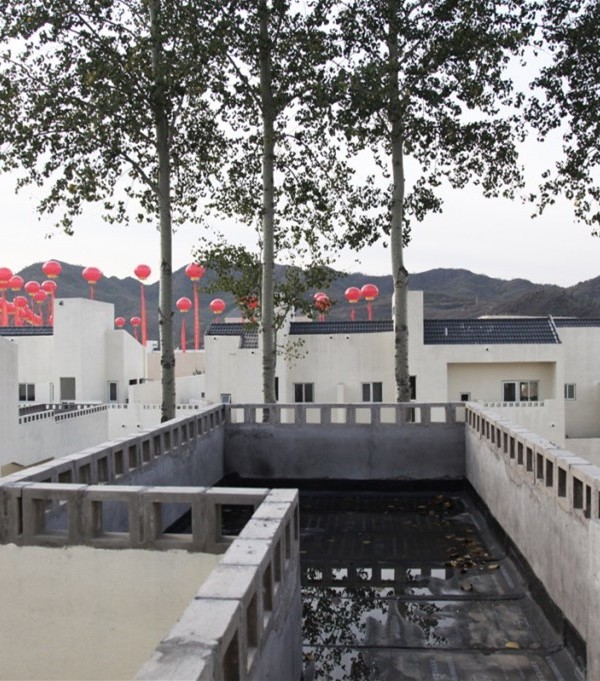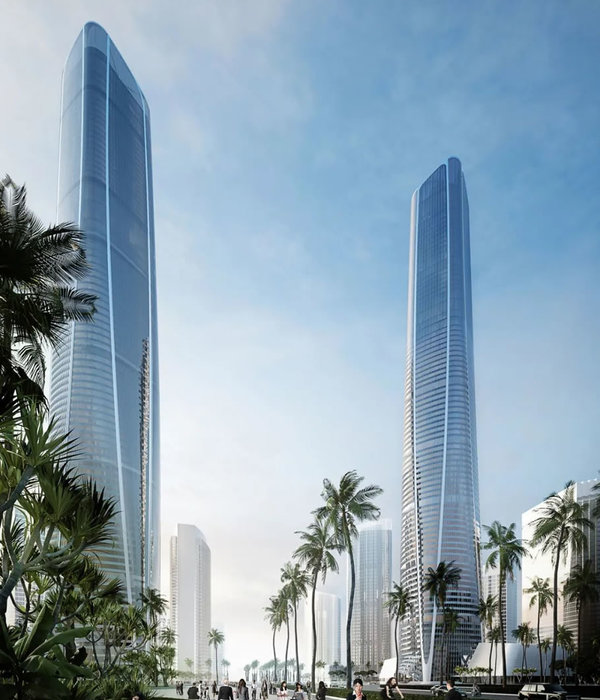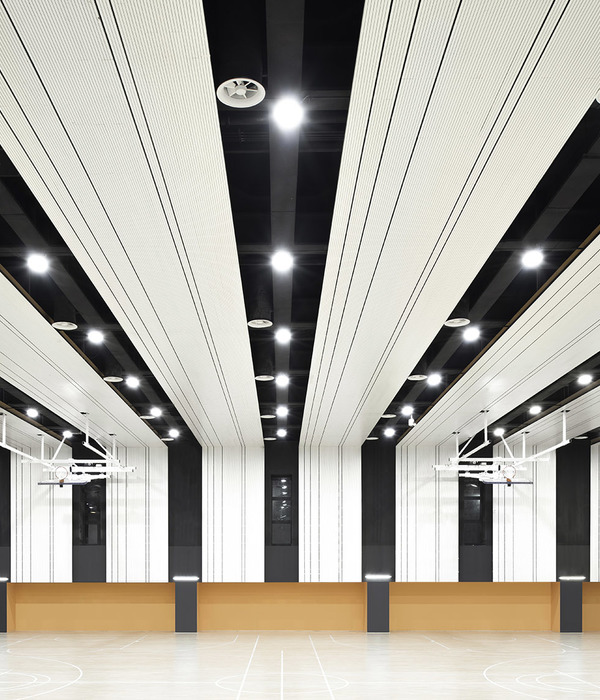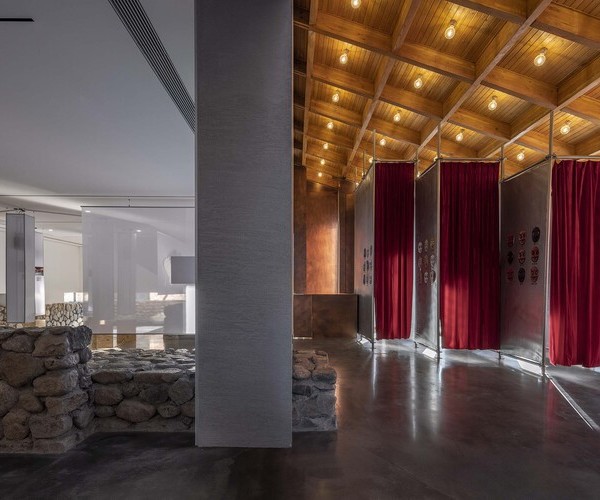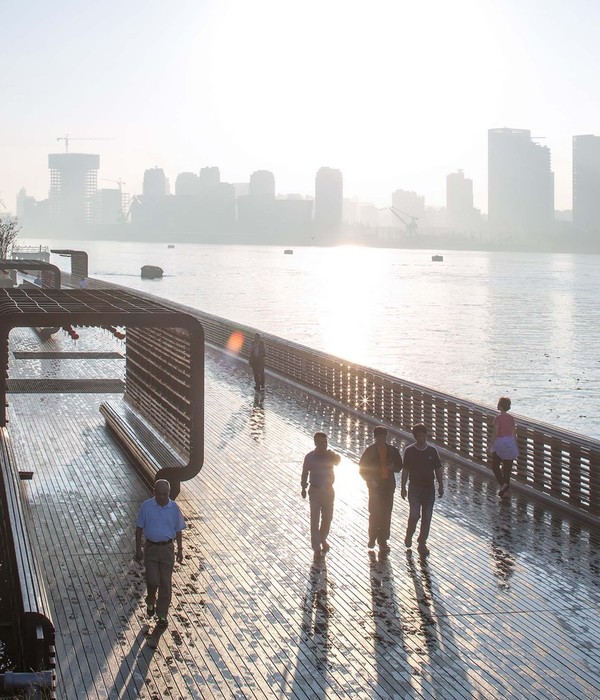Baan Pomphet酒店外观的设计灵感来自于项目场地及其周边环境。场地不仅包括古老的纪念碑“Pom Phet”,还拥有俯瞰帕萨克河与湄南河交汇处美景的绝佳视野。随着水流起起伏伏的水葫芦,在夏季铺满整个河面。两河交汇于此形成的漩涡,成为场地独一无二的风景。
The inspirations for Baan Pomphet’s exterior design come from the quality of the site and its surrounding, namely an ancient monument “Pom Phet”. By “quality of the site”, it is meant the best location that overlooks a scenery where the “Pa Sak River” meets the “Chao Phraya River”. Water hyacinth normally float up and down these rivers and cover the entire surface of the water in summer mornings. What is special about this movement is the whirlpool where the two rivers meet. It is rare to find such scenery elsewhere.
▼河畔酒店远观,view of the hotel near the river from distance © Wison Tungthumya
事务所在设计建筑及包括滨江平台的各平台布局时,将顾客的视野视为最重要的考量因素。如何在尽可能为客户带来绝佳视野的同时,还能保护他们的隐私,是该项目的重点。在总体规划中,设计师将餐厅和酒店这两座建筑分开,利用主流线的规划,使得每个人一进入场地就能欣赏的河流景观。
When we compose the layout of the buildings and all the decks including the riverfront deck, we are concerned about the view for all guests: how to share the best view as much as possible and the hotel guests still have their privacy. In the master plan, we separate the two buildings, the restaurant and the hotel, and leave the main circulation for everyone to see the river right away when they enter the site.
▼建筑平台的布局充分考虑游客的视野,layout of the decks, take the view of tourists into consideration © Wison Tungthumya
▼上层平台上视野开阔,broad view on the upper decks © Wison Tungthumya
Pom Phet堡垒是由漆为白色的砖和水泥构成的,因此在该项目中,设计师选择继续采用砖材料。砖块是大城府非常常见的建筑材料。设计师为建筑选择了四种不同尺寸的手工砖。每种砖的宽度和厚度相同,仅长度不同,分别是4,5,6厘米。将这些手工制作的砖块以独特的手法拼接,建筑的墙壁和地板成为更为独特的手工艺品。墙壁凹凸不平的纹理呈现出光影斑驳的变化。项目中所用的手工砖来自于距场地30分钟车程的本地砖厂,BPK。这种手工砖非常小,呈现出特殊的橙色。设计师用这些砖块为墙壁和地板拼接出6中不同的图案。BPK生产的砖块在砖炉内用木材烧制,且手工控制砖炉。因为不像其他工厂一样使用气体来同一控制砖的质量,所以BPK出炉的砖块的橙色有一定的差异性。
Pom Phet fortress is brick structure and cement painted in white colour. We follow these materials and choose to work with bricks. Bricks are a common material in Ayutthaya. We intend to use 4 different size of handmade bricks, the length of the brick in each size is different, which are 4, 5, 6 and 15 centimetres, the width and the thickness are the same. These handmade bricks are craft in themselves and we even add the craftsmanship to the process of building the walls and the floors. Different textures of the walls seem to capture light and shadow differently. Baan Pomphet’s handmade bricks are produced by the local brick factory named BPK, a 30-minute drive from the site. The bricks are especially small, arranged in 6 different walls and floor patterns and its colour is a special orange. BPK bricks are baked by firewood in a brick oven. Bricks that come out from this oven have slightly random orange colours as BPK brick ovens are manually controlled unlike any other factories that use gas to control the bricks’ quality and the consistency of their orange colour.
▼餐厅与客房间的主通道,main circulation between the restaurant and hotel rooms © Wison Tungthumya
▼墙壁凹凸不平的纹理呈现出光影斑驳的变化,different textures of the walls seem to capture light and shadow differently © Wison Tungthumya
▼酒店主楼梯,砖块拼接出不同图案,main staircase of the hotel, bricks are arranged in different patterns © Wison Tungthumya
该项目其中一个有趣的灵感来自于业主自己。业主Saralee Rattanapuchpong是大城府本地人,他的家人在与Baan Pomphet相同的街道上经营着另一家成功的餐厅。Saralee要求酒店的客房修建在厨房之上。对Saralee来说,这个项目不仅仅是能容纳160个座位的餐厅和8间客房的酒店,同时也是她的家。Saralee性格友好,热情欢迎每一位到来的客人。因此,设计团队将建筑控制为较小的规模,以此营造出温馨而舒适的氛围。这样的建筑形式能让人联想起在泰语中被称为“baan baan”的传统房屋。 项目中采用了许多泰国建筑中常见的细节结构,例如每间酒店房间门前的木质楼梯,或是铁艺与木艺结合的酒店主楼梯。设计师认为,砖,木材及手工瓷砖一类的天然材料可以为建筑带来温度。
A more interesting inspiration, come from the owner of the project herself. Saralee Rattanapuchpong is an Ayutthaya local whose family already had a successful restaurant on the same road with Baan Pomphet. She asked us to design the bedrooms of her family above the kitchen of Baan Pomphet. To her Baan Pomphet is not only a 160-seat restaurant and an 8-room hotel. It is also her family’s home. Her character is friendly and gentle, always welcome everybody as her guests. So, we think that the scale of the buildings should be small and we wish to build something for her that is warm, welcoming and cozy. Something that will remind us of Thai vernacular house, or baan baan in Thai language. This word is meant that the details are normally seen in Thailand, such as the wooden stairs in front of each hotel rooms. The same is true of the iron and wooden main staircase of the hotel. To us, natural materials, like brick, wood and handmade ceramic tile, are warmth and lovely.
▼通向客房的木质楼梯,wooden stairs towards hotel rooms © Wison Tungthumya
▼客房楼梯细节,detail of the stairs to hotel rooms © Wison Tungthumya
Baan Pomphet酒店的设计让客人在探索通向河岸的不同空间时,总能源源不断地发现惊喜,比如在河边的Pom Phet堡垒边设置的观赏点,又比如泳池边只有内部游客才能欣赏到的菩提树。泳池和主通道之间用木墙分隔。木墙既成为酒店木质的主楼梯的延伸,又增强了空间的隐私性。其次,酒店场地中有一棵优美的菩提树,事务所请来专家为它精心修剪树形。为保护菩提树,酒店建筑的地基尽量远离了树根。该树成为酒店三维空间构成的灵感之源。为了让顾客能够欣赏到整棵菩提树,设计师仔细考量了游泳池的高度。场地内风力强劲,设计师在布置酒店房间时,还需要考虑建筑内部的通风要求。
Baan Pomphet is expected to be welcoming and as one explores each spaces, there are more surprising elements further down towards the river such as a viewpoint of brick Pom Phet fortress next to the rivers, and a huge Bodhi Tree next to a swimming pool which only visible to the guests from the inside. We also decide to build a wooden wall between the swimming pool and the main circulation, as an extension of the main wooden staircase of the hotel. This is to increase privacy for the hotel guests. Secondly, the land of Baan Pomphet has an elegant Bodhi Tree, carefully trimmed by our tree surgeons and preserved by constructing the building foundations as far as possible from its roots. The Bodhi Tree is an inspiration in term of space composition in three-dimension. We set the level of the swimming pool and the main circulation for the guests to see the elevation of Bodhi Tree. Thirdly, the wind in this site is very strong. This is a desire to have natural ventilation when we compose the hotel rooms.
▼木墙分隔空间,增强隐私性,wooden walls separate the space which increase privacy © Wison Tungthumya
▼泳池被抬高,raised swimming pool © Wison Tungthumya
▼从檐下看向造型优美的菩提树,view of the beautiful linden tree from the eaves © Wison Tungthumya
▼泳池边的半开放空间和泳池细节,semi-open space near the pool and details © Wison Tungthumya
Baan Pomphet餐厅内部的主色调采用了烤河虾的橘色。烤河虾是大城府当地最著名的一道菜,其颜色与建筑外部砖墙的颜色非常相似。从餐厅主入口进入,游客会先进入一间带有烟囱的木制建筑,“烤河虾屋”,随后经由主通道进入餐厅。餐厅的天花板上装饰有名为chanang的传统渔具,并将它们改造成吊灯。这种器具在泰国当地被用来捕捞鱼虾,是传统劳动人民智慧的象征。同时,chanang衍生的编织物也被当作装饰,挂在餐厅的墙上。
▼餐厅的天花板上装饰有名为chanang的传统渔具,ceiling of the restaurant is decorated with traditional fishing gear called chanang © Wison Tungthumya
▼从餐厅看向庭院,木材结构的颜色与橙色的砖墙相比配,view of the courtyard from the restaurant, the color of the wood structure matches the orange brick wall © Wison Tungthumya
The main colour for Baan Pomphet restaurant interior is grilled river prawn fat orange. Grilled river prawn is a most famous dish of Ayutthaya. This orange goes with the exterior brick colour. From the entrance of Baan Pomphet, the guests would see the grilled river prawn room (wooden mass with a wooden chimney) before they walk through the main circulation to the restaurant. We work with chanang, a Thai utensil for catching prawns and other small fish in the river. This utensil represents traditional knowledge of the villagers. We arrange them on the restaurant’s ceiling as the hanging lamps. Moreover, we use chanang’s weaving details on the wall of the restaurant.
▼餐厅吧台,counter in the restaurant © Wison Tungthumya
▼餐厅墙壁上的编织装饰,weaving details on the wall of the restaurant © Wison Tungthumya
酒店的内部采用了两种从食物中提取的颜色为主色调。一楼的房间采用了来自Cha-plu的绿色。Cha-plu是泰餐中常见的配料,颜色为深绿色,口味略苦。二楼的房间采用了菠萝蜜的黄色。菠萝蜜甜而鲜,因而经常被用做泰式糖果的原料。酒店室内装饰以简约风为主,使室内的简洁与室外丰富的细节形成对比。对比亦发生在室内的绿色和黄色与室外砖块和木材的色彩之间。
▼以绿色为主色调的酒店房间,room in green © Wison Tungthumya
▼以绿色为主色调的浴室,bathroom in green © Wison Tungthumya
The hotel rooms have two interior colours, both of them come from the colours of food. The ground floor rooms are cha-plu leaf green. Cha-plu leaf is a common ingredient for Thai food. Its colour is dark green and it tastes slightly bitter. The first floor rooms are jackfruit yellow. Thai sweets tend to have jackfruit as an ingredient. Its taste is sweet and fresh. The interior design focuses on simplicity. When we look at the interior and the exterior, we see the contrast between the simplicity and the complexity of construction details. The green and yellow colours are also contrast with the brick and the wood colours.
▼以黄色为主色调的酒店房间,room in yellow © Wison Tungthumya
▼以黄色为主色调的浴室,bathroom in yellow © Wison Tungthumya
哈努曼(Hanuman)门把手是Baan Pomphet酒店充满设计感的小元素之一。在罗摩衍那史诗中,哈努曼是印度风神瓦尤(Vayu)的儿子。我们选择用哈努曼来象征酒店中的风。酒店的哈努曼门把手像是一只鼓起脸颊的猴子,猴子的毛发沿顺时针的方向旋转成风涡的形状。门把手由Chunsiri Chai-ear绘制形状,再由柚木进行手工制作。在轮廓绘制完成后,需要根据木材的层次制作电子模型。手工制作的产品往往比机器切割更具魅力。木制的门把手没有锋利的边缘,因而脸颊处呈现出立体的弧度。更重要的是,酒店中目前安置有16个这样的门把手,每个门把手都因手工制作而呈现出略微的不同。Baan Pomphet体现出业主,建筑师和工匠之间良好的合作关系,在这个项目中,每个部门都展现出了自己最精湛的技艺。
▼充满设计感的门把手,small design elements doorknobs © Wison Tungthumya
Hanuman doorknobs are small design elements at Baan Pomphet. Hanuman in Ramayana Epic is a son of Vayu, the Hindu wind god. We choose Hanuman to signify the wind in Baan Pomphet. Hanuman doorknob at Baan Pomphet is a monkey that has bulgy cheeks, its hairs move clockwise in circular and blowing the circular wind. Chunsiri Chai-ear drew the Hanuman doorknob to be later on handcrafted in teak. After the drawing is finished, it is important to do a digital 3D model according to the technique of layering the wood. However, the touch by hand is more charming than machine made. There is no sharp edge of wood and Hanuman’s cheeks are a bit curved three dimensionally. Most importantly, each faces look slightly different. We now have 16 of them in Baan Pomphet. Baan Pomphet portrays trust between the owner, the architects and the craftsmen. The project enables everyone to exhibit their best skills.
▼夜色中酒店的灯光倒映在湖面上,lights of the hotel are reflected on the lake at night © Wison Tungthumya
▼夜晚的后庭院,backyard at night © Wison Tungthumya
▼屋顶平面,roof plan © onion
▼建筑平面,plan © onion
Project name: Baan Pomphet Building type: restaurant and 8-room-hotel Owner: Saralee Rattanapuchpong Location: Next to “Pom Phet” Ancient Fortress, U Thong Road, Ayutthaya Completion: 2020 Architect: Onion Co. Ltd. And M.L.Chittawadi Chitrabongs Lead Architects: Arisara Chaktranon, Siriyot Chaiamnuay, ML Chittawadi Chitrabongs Interior designer: Onion Co. Ltd. Structural engineer: Sawekchai Tangaramvong Contractor: Double Click Construction Co. Ltd. Building area: 2,020 square meters Land area: 1,492 square meters
{{item.text_origin}}

